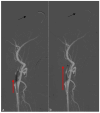The T-Top Technique for Tandem Lesions: A Single-Center Retrospective Study
- PMID: 40363977
- PMCID: PMC12072886
- DOI: 10.3390/jcm14092945
The T-Top Technique for Tandem Lesions: A Single-Center Retrospective Study
Abstract
Background: Tandem Lesions (TLs) or Tandem Occlusions (TOs) are characterized by simultaneous high-grade stenosis or occlusion of the proximal extracranial internal carotid artery and the intracranial terminal internal carotid artery or its branches. These lesions can result in stroke and pose significant challenges to endovascular treatment. This study introduces and evaluates the "T-Top technique" as an innovative approach to address TLs, assessing its safety and technical efficacy. Methods: Data from acute ischemic stroke (AIS) patients treated with the T-Top technique between September 2022 and September 2023 were retrospectively analyzed. The technique involves using the pusher wire of a stent retriever as a microwire to guide a monorail angioplastic balloon to the extracranial carotid stenosis, performing angioplasty simultaneously with stent retriever anchorage. Clinical outcomes, procedural data, and safety were assessed. Results: Successful reperfusion (mTICI > 2b) was achieved in 91% of cases, with a median groin puncture to final recanalization time of 50 min. Favorable clinical outcomes (mRS < 3) were observed in 69% of patients, with a low mortality rate of 6% after 90 days. Conclusions: The T-Top technique offers a rapid and reliable strategy for TL treatment, improving reperfusion rates and clinical outcomes. Further studies are warranted to validate its efficacy in larger cohorts. This technique holds promise for enhancing endovascular treatment outcomes in patients with Tandem Lesions.
Keywords: endovascular neurosurgery; internal carotid artery (ICA) stenosis; middle cerebral artery (MCA) stenosis; new technique; stroke; tandem lesions; tandem occlusions.
Conflict of interest statement
The authors declare no conflicts of interest.
Figures





Similar articles
-
The ReWiSed CARe Technique : Simultaneous Treatment of Atherosclerotic Tandem Occlusions in Acute Ischemic Stroke.Clin Neuroradiol. 2020 Sep;30(3):489-494. doi: 10.1007/s00062-019-00795-z. Epub 2019 May 22. Clin Neuroradiol. 2020. PMID: 31119326
-
Passing Extracranial Artery Occlusion by Intermediate Catheter With Expanding Microballoon (PEACE): A Novel Endovascular Therapy in Acute Tandem Occlusion Stroke.J Endovasc Ther. 2022 Oct;29(5):790-797. doi: 10.1177/15266028211064818. Epub 2021 Dec 12. J Endovasc Ther. 2022. PMID: 34894849
-
Management of acute ischemic stroke due to tandem occlusion: should endovascular recanalization of the extracranial or intracranial occlusive lesion be done first?Neurosurg Focus. 2017 Apr;42(4):E16. doi: 10.3171/2017.1.FOCUS16500. Neurosurg Focus. 2017. PMID: 28366065
-
Revascularization of tandem occlusions in acute ischemic stroke: review of the literature and illustrative case.Neurosurg Focus. 2017 Apr;42(4):E15. doi: 10.3171/2017.1.FOCUS16521. Neurosurg Focus. 2017. PMID: 28366063 Review.
-
Revascularization of carotid artery occlusion using stenting versus non stenting in endovascular management of tandem occlusion stroke.J Clin Neurosci. 2022 Apr;98:15-20. doi: 10.1016/j.jocn.2022.01.036. Epub 2022 Feb 4. J Clin Neurosci. 2022. PMID: 35131720 Review.
References
-
- Goyal M., Menon B.K., van Zwam W.H., Dippel D.W.J., Mitchell P.J., Demchuk A.M., Dávalos A., Majoie C.B.L.M., van der Lugt A., de Miquel M.A., et al. Endovascular thrombectomy after large-vessel ischaemic stroke: A meta-analysis of individual patient data from five randomised trials. Lancet. 2016;387:1723–1731. doi: 10.1016/S0140-6736(16)00163-X. - DOI - PubMed
-
- Assis Z., Menon B.K., Goyal M., Demchuk A.M., Shankar J., Rempel J.L., Roy D., Poppe A.Y., Yang V., Lum C., et al. Acute ischemic stroke with tandem lesions: Technical endovascular management and clinical outcomes from the ESCAPE trial. J. Neurointerv. Surg. 2018;10:429–433. doi: 10.1136/neurintsurg-2017-013316. - DOI - PubMed
-
- Anadani M., Spiotta A.M., Alawieh A., Turjman F., Piotin M., Haussen D.C., Nogueira R.G., Papanagiotou P., Siddiqui A.H., Lapergue B., et al. TITAN (Thrombectomy In TANdem Lesions) Investigators, Emergent carotid stenting plus thrombectomy after thrombolysis in tandem strokes: Analysis of the TITAN registry. Stroke. 2019;50:2250–2252. doi: 10.1161/STROKEAHA.118.024733. - DOI - PubMed
LinkOut - more resources
Full Text Sources
Miscellaneous

